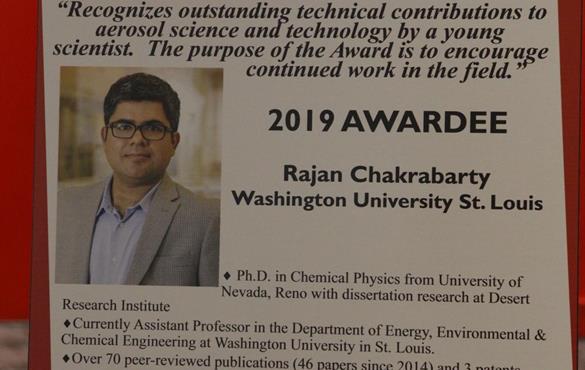Chakrabarty wins Kenneth T. Whitby award for aerosol research
Rajan Chakrabarty, assistant professor of energy, environmental & chemical engineering, received the prestigious 2019 Kenneth T. Whitby Award from the American Association for Aerosol Research Oct. 16

Rajan Chakrabarty, assistant professor of energy, environmental & chemical engineering in the McKelvey School of Engineering at Washington University in St. Louis, received the 2019 Kenneth T. Whitby Award from the American Association for Aerosol Research (AAAR) Oct. 16 in Portland, Oregon.
The Kenneth T. Whitby Award honors Whitby's contributions to aerosol measurement, the study of aerosol properties and behavior and the nature of atmospheric aerosols, as well as his establishment of the University of Minnesota's Particle Technology Laboratory in the Department of Mechanical Engineering. Recipients of the award must have earned his or her highest degree in 2008 or later and have nominations from an AAAR member and from other supporters.
AAAR is recognizing Chakrabarty for his outstanding contributions to experimental and modeling techniques and characterization of aerosols that have significantly advanced the field. In his letters of recommendation, Chakrabarty was commended for his "body of work, which is without peer in the aerosol community at mid-career"; "soup to nuts characterization of light-absorbing carbonaceous aerosol involving laboratory and field measurements and a healthy dose of first-rate optical physics"; "addressing two long-standing problems: the ballistic-to-diffusive transition in nonthermally driven systems and aerosol-to-gel kinetics"; and for "inventing a flame-based continuous aerosol gel synthesis technique and a technique to classify particle morphology using electrostatic classifiers."
The world-renowned Center for Aerosol Science and Engineering (CASE) at Washington University continues to be recognized for its pioneering work. Pratim Biswas, the Lucy & Stanley Lopata Professor, assistant vice chancellor and chair of the Department of Energy, Environmental & Chemical Engineering, received the award in 1991; Jian Wang, professor of energy, environmental & chemical engineering, received the award in 2013; and alumnus Chris Hogan, who earned a doctorate in energy, environmental & chemical engineering in 2008 and is now a professor and director of graduate studies at the University of Minnesota, received the award in 2018.
"We are delighted that Rajan Chakrabarty's work has been recognized by our national aerosol society," Biswas said. "Rajan is an innovative thinker and uses a fundamental approach to unravel the characteristics of a variety of non-equilibrium aerosol processes. The results of his work will enable develop a more accurate understanding of important atmospheric processes and enable synthesis of novel materials."

In August, Chakrabarty received the 2019 Schmauss Award from the German Association for Aerosol Research (Gesellschaft für Aerosolforschung) at the European Aerosol Conference in Sweden. The award, given to outstanding young scientists under age 40, recognized Chakrabarty for his significant contributions to the characterization of the optical properties of carbonaceous aerosols with implications to radiative forcing, climate change and remote sensing. In 2018, he received the Global Environmental Change Early Career Award from the American Geophysical Union; in 2017 he received the Goody Award from the Electromagnetic Light Scattering Society; and in 2015 he received a CAREER Award from the National Science Foundation. He has published more than 70 peer-reviewed publications and holds three patents.
Chakrabarty leads the Complex Aerosol Systems Research Laboratory, which works at the forefront of addressing grand challenges associated with characterization, synthesis, granular-level modeling, radiative forcing estimation and remote sensing of particulate matter existing in nonequilibrium conditions. Over the years, his research group has made technical contributions to aerosol science and technology focusing on the themes of addressing grand challenges associated with radiative forcing by carbonaceous aerosols; open-source and user-interactive aerosol physics software development; advances in fundamental aerosol physics, and aerosol instrumentation and engineering techniques. Research advances in these areas have a tremendous broader impact in the societally highly relevant research areas of atmospheric radiative forcing and climate change, satellite remote sensing and governmental policy making, especially in developing countries.
Chakrabarty joined the faculty at Washington University in St. Louis in 2014. He is a faculty fellow in the university's Center for Aerosol Science and Engineering and in the McDonnell Center for the Space Sciences. Previously, he was an assistant research professor at the University of Nevada-Reno/Desert Research Institute. Chakrabarty earned a doctorate in chemical physics and a master's in atmospheric physics from the University of Nevada-Reno and a bachelor's degree in electronics and instrumentation engineering from the University of Madras in India.



